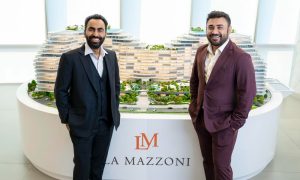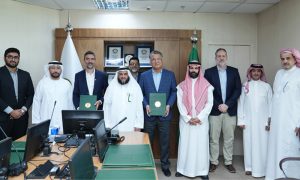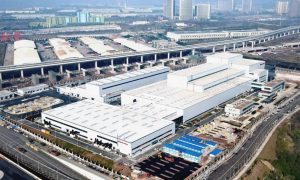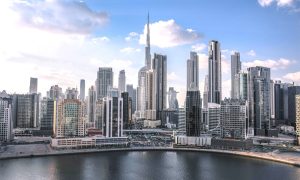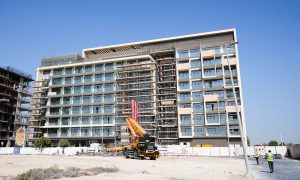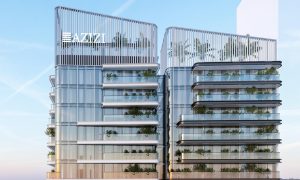The world’s best kept secret
Onsite at Kizad’s 51sq km Zone A

I’m sat in a car with ADPC’s Brian Sadler; we’ve been driving for over an hour on a whistle stop tour of the largest industrial development zone known to man.
It’s a trip ADPC officials make by helicopter on a monthly basis to track the progress of the development. As we tour the site I think back to an interview with ADPC CEO Tony Douglas, who said: “The reality of it is there is almost no vocabulary that I posses, that allows me to express the scale of what we’re talking about.
“I’ll use whatever superlatives I can conjure up, imagery that we can give you, but honestly when you go there you’ll think ‘oh, this is what he was going on about’.”
Already aware that Kizad is four times the size of Abu Dhabi Island and that the landmass of Zone A equates to 340 football pitches – or two thirds the size of Singapore – I’m still left thinking ‘oh, this is what he was talking about’.
During the whistle stop tour we cover a vast area of the 51 square kilometre Zone A – the entire Kizad development will cover 417 square kilometres with Zone B, “the big part”, on the other side of the E11.
We drive to the outermost port from where the world’s longest conveyor belt, at 14 km, appears half the size, and the world’s largest aluminium smelter, operated by EMAL, and its neighbouring Taweel power plant are dwarfed on the horizon.
Zone A was officially launched a year ago next month. The first ships docked on August 25 with up to two ships per month docking at the port until completion in March 2012 and full operations are rolled out in Q4 that year, offering annual capacity of 2 million containers a year and 8 million tonnes of bulk and break bulk cargo. The first ever tugboats were welcomed on September 15.
Construction will continue until 2030 by which time the entire development will be able to handle 15 million TEUs and 35 million tonnes of bulk cargo, with EMAL handling 4 million tonnes of cargo a year at its exclusive berth.
By this time Kizad will provide 150,000 jobs and have 100,000 residents.
It’s also casually dropped into conversation that there are there are currently 11,500 construction workers on site.
Planning tomorrow today
A staggering US $7.2 billion has been invested in the development and to maintain the official ADPC line that planning has been “strategic” is an understatement.
While Douglas explains the key to a successful infrastructure project is to build it for the future, we pass culverts that are being built now to facilitate expansions over the next generation; a 12 lane super highway will replace the road we are on today – part of a network that will intersect the development to provide efficient road links to the E11, with smaller roads constructed for use by fully automated vehicles transporting cargo from ships to shore. The first and third longest bridges in the UAE are already here and Etihad Rail’s national network will also serve the area.
Part of the land is reclaimed, for which the biggest dredging fleets in world at the moment have been put to work, even excavating enough land for the next phase of expansion.
Following the delivery of the ship to shore cranes in August, the container yard – the first automated container yard in the Middle East – is now ready to handle the ships of tomorrow, which Douglas says are “significantly bigger” than the ones the old cranes were originally installed to handle.
“On a mega project like this, the greatest consideration is that you are building for generations to come. You need to anticipate, to some degree, the future and the one relatively easy bet to make is that international shipping will get a lot bigger. So when you stack the cranes you have to do it where they are going to be taller, because the ships will be higher and they will have to reach further,” he says.
Going on to describe how the 3.2km key wall is massive, he says that it has been designed so up to two more can be added as the development, and market, demand (see images).
Big Business
Mistakenly assuming that I can’t be shocked any more, I ask Sadler how people react when he tells them he is the area construction manager for the definitive mega project. His reaction? “Nobody outside the industry knows what I’m talking about. It’s like the world’s best kept secret, without actually being a secret.”
He’s right; despite the reaction, the team behind Kizad are far from secretive about its progress – or future.
Currently travelling the world to showcase Kizad to potential investors, the team has already visited India, China, South Korea and Germany, with the UK and US next on the hitlist.
It’s a strategy that got off to a flying – or driving – start when the project was unveiled to the public on November 13 2010 at the Abu Dhabi Grand Prix.
“We started with the local market and then identified five additional markets. We then went to the Hannover Messe in March where we had a very successful European launch,” says Douglas adding the international roll out has gone to plan.
A number of alliances have also been brokered with international banks to provide a specific position within various markets. Firstly HSBC to leverage markets in China and Hong Kong and most recently India’s Bank of Baroda and the Commercial Bank of China Ltd (ICBC).
“That has proven to be very successful as it gets you straight into a far more mature, targeted, strategic conversation very quickly. Trying to achieve that the other way would mean spending a lot of time trying to explain what Kizad is and finding the people you need to get to see,” Douglas explains, adding the strategy was a “smart move” to establish mature relationships quickly “on the top floor of all the big corporate buildings”.
That’s not to say the success to date is making ADPC complacent. While Douglas agrees the project has started well he goes no further than calling it a “realistic start”, upon which Abu Dhabi’s 2030 Vision can continue to be met.
Explaining there are “massive variables”, such modesty is not only realistic but refreshing; a global project must encompass global economics. Recalling the impact of a worldwide financial crisis on the initial roll out of the project, Douglas says that despite improvements in Kizad’s worldwide target markets “we certainly wouldn’t want to get to the point where we get ahead of ourselves.”
“This is about making sure you have a very strong and compelling proposition because the big test is to come – to convert the intention into reality – which is why the day job down on the site is no nonsense, big project, hard-nosed delivery, and failure is quite clearly not an option,” he asserts.
“You have to think about it in the currency of the next generation. Whilst we are very pleased with all of the early progress we have made we certainly wouldn’t get carried away.”
Talking tactics
Kizad isn’t just a huge construction project, the business plan behind it underpins Abu Dhabi’s goal to increase GDP four fold, generating $418 billion from non-oil and gas sectors. Kizad’s role in this target will see it responsible for 15% of this figure and the sectors that will generate these revenues have been very carefully selected.
Kizad is divided into clusters for eight key sectors with a ninth for mixed use and other industries (see box). Within each zone an entire production line will be facilitated. For example, EMAL’s aluminium production will be supported by upstream, downstream and production operations, all situated in close proximity to minimise and time and carbon impact of transportation.
The diversity of the clusters and pledge to give investors the ultimate one stop shop, requires a level of tactical planning that is in itself as amazing as the construction project.
“When we got into the tactical execution of it, knowing we have to have the ability to provide a one stop proposition when every customer has different requirements is about recognising that yes, you are a bespoke client and therefore we have configured ourselves to be able to offer a bespoke solution and the tactical execution of it. And I think that’s the key to it,” Douglas begins.
Douglas explains the business proposition Kizad promotes as a three dimensional matrix.
The first dimension is the businesses that are local to the UAE or regional; joint ventures of regional businesses with an international partner and following the government announcement of International Investment Zone Status last November, 100% foreign owned companies.
The next dimension is dealing with businesses that have the capability to project manage the installation of all their own facilities. Of this group Douglas says there are those who can but have never done within Abu Dhabi and there are those that have no capability and intention to shoulder that responsibility. Douglas explains the third dimension comes back to the relationship Kizad has with international banks.
“Unsurprisingly we find you have companies with the capacity to completely fund a venture themselves, companies who have got capacity to fund it themselves but are looking for a blend of local and self funded investment and then companies who need financial assistance.
“Those three dimensions; be it the type of business from local to fully international, in terms of can they develop it here, from yes totally through to not a chance, to can they fund it with assistance, we’re finding we have every combination in that matrix,” Douglas continues.
“Let’s imagine you’re an international business, you want wholly owned status, we can do that. Also with a land framework that gives you 100% foreign ownership status, we can give you free zone trading status.
“You may have the capability to set up your own massive processing plant but you’ve never done one here, in which case we will help you with that. And you might have the ability to fund a venture but in terms of tax efficient structuring you may want to have some of it blended with local investment,” he sums up.
“We’ve had fascinating responses.”
National treasure
While industry may not have the cleanest image, ADPC has invested $240m to conserve the local environment, particularly the coral reef, leaving the site not only protected, but healthier than previously, a claim proven by the hundreds of species of marine life visible from the shore during our visit.
Referring to the Gulf’s only coral reef as “a national treasure”, Douglas has joined the marine scientists on their regular dives to monitor the reef as part of the conservation work, diving in an area closed off to the public.
To protect the 7km reef, a breakwater measuring 8km has been built and Sadler says the way the port is constructed will prevent, should an accident occur, any chemicals or other products from leaking out beyond the port.
The coral is satellite mapped and also monitored through reference points on the seabed, to enable immediate recognition of its development during camera drags.
“The reef is in fantastic condition and the good news is all of the engineering that went into the break water has been completely successful so this reef will remain a national treasure for the future,” Douglas says.
It’s part of ADPC’s environmental and social responsibility work which also includes a sustainability plan and waste management. The work hasn’t gone unnoticed; last year ADPC won the environmental protection award at Seatrade Middle East.
Back on dry land Douglas and his team are understandably proud of their achievements to date, with the work that is still to come merely the next step in the evolution of the port.
“I genuinely can’t think of any examples anywhere, which are as exciting as this in terms of sheer scale, technical and engineering endeavour, the way of trying to bring the resources of many big organisations together and align them with one simple, common objective, which is to deliver this on time and within budget safely,” he concludes.









